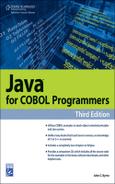Book Description
COBOL, one of the oldest programming languages in current use, still provides the framework for many vital business, finance, and administrative programs and systems that companies and governments use in day-to-day activities. Scores of organizations are deciding to replace these legacy systems, including their core business systems, with more modern ones written in Java. The people who support these systems are valuable repositories of business process information, and they know how computer systems are used to meet those business process requirements. But they often don't know Java. That's where this book comes in. Java for COBOL Programmers,Third Edition uses COBOL examples to teach object-oriented principles and Java syntax. Instead of describing the Java object concepts and syntax in the abstract, or based on references using C or C++ programming languages, Java for COBOL Programmers, Third Edition presents various object-oriented concepts first in a COBOL context, and then in the Java syntax that supports this concept.Then, after users are familiar with the underlying concepts, additional Java language rules are defined. For programmers trying to use Java in a real-world environment, this third edition has been updated to reflect the latest developments in the Java language and programming standards. Advances in the language, such as the new Generics feature, are covered. New alternatives for stream-based input and output processing methods are introduced, along with the latest XML processing options in Java. Also new in this edition is a chapter on the Eclipse graphical integrated development environment. This product is presented using a guided, step-by-step progression. You can use the chapter exercises to explore helpful Eclipse features, such as smart editing, debugging, and refactoring.
Table of Contents
- Cover Page
- Title Page
- Copyright Page
- Dedication Page
- About the Author
- Contents
- Introduction
- Part I: Introducing Java
- Chapter 1: Objects and Classes
- Chapter 2: Introducing the Java Development Environment
- Chapter 3: Messages and Methods
- Chapter 4: Class Members
- Chapter 5: Inheritance, Interfaces, and Polymorphism
- Inheritance and Object-Oriented Design
- Inheritance and Objects
- Inheriting Methods
- Redefining a Method
- Extending a Method
- Why Inheritance?
- Inheritance, Objects, and COBOL
- More COBOL Object-Oriented Design Patterns
- Inheritance and Java
- ErrorMsg Class
- PopupErrorMsg Class
- PrintfileErrorMsg Class
- TextMessage Class
- ErrorMsg Class
- PopupErrorMsg Class
- PrintfileErrorMsg Class
- Consumer Class
- TextMessage Class
- ErrorMsg Class
- ErrorMsg Class: Override
- PopupErrorMsg Class
- PrintfileErrorMsg Class
- Consumer Class
- PrintfileErrorMsg Class
- Sharing Variables and Methods
- Hiding Variables and Methods
- The this Variable
- Java Interfaces
- Using Interfaces
- Hiding Methods and Members
- Polymorphism
- Exercises
- Reviewing the Samples
- Part II: Java’s Syntax
- Part III: Introducing Enterprise Java
- Part IV: Appendixes
- Appendix A: About the CD-ROM
- Appendix B: Java Information Available Elsewhere
- Appendix C: Buzzwords
- Active Server Pages (ASP)
- AWT
- Client/Server
- Common Object Request Broker Architecture (CORBA)
- Components
- Component Object Model (COM)
- Distributed Component Object Model (DCOM)
- Enterprise JavaBeans (EJBs)
- File Transfer Protocol (FTP)
- Firewall
- Hypertext Transfer Protocol (HTTP)
- Integrated Development Environment (IDE)
- Interface Definition Language (IDL)
- Internet Inter-ORB Protocol (IIOP)
- JavaBeans
- Java Native Interface (JNI)
- JavaScript
- Java Server Pages (JSP)
- JDBC
- Microsoft Foundation Classes (MFC)
- Open Database Connectivity (ODBC)
- Remote Method Invocation (RMI)
- Remote Procedure Call (RPC)
- Secure Sockets Layer (SSL)
- Swing
- TCP/IP
- Unified Modeling Language (UML)
- Uniform Resource Locator (URL)
- VBScript
- Web Services
- Appendix D: Sun Microsystems, Inc. Binary Code License Agreement
- Index
